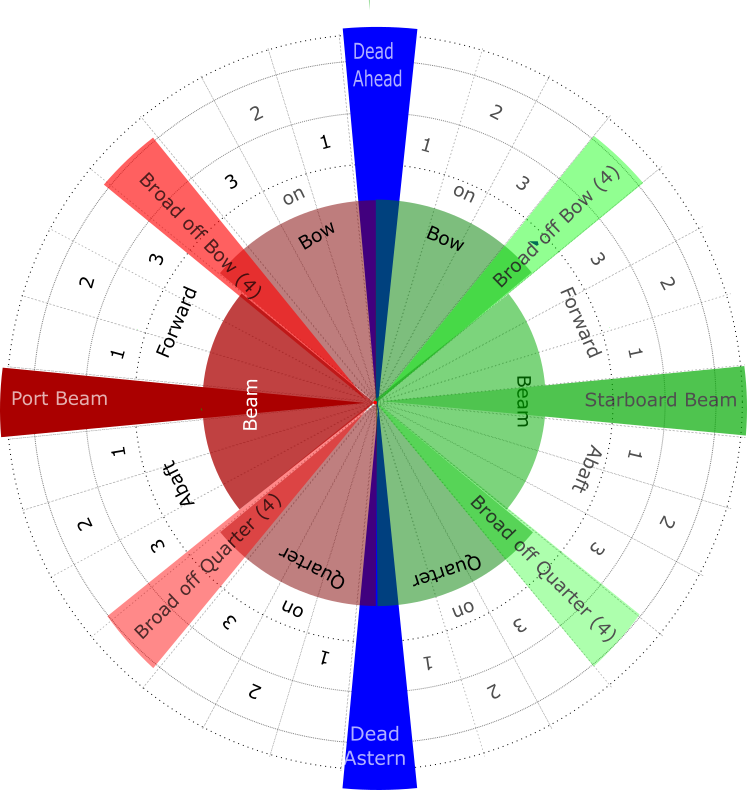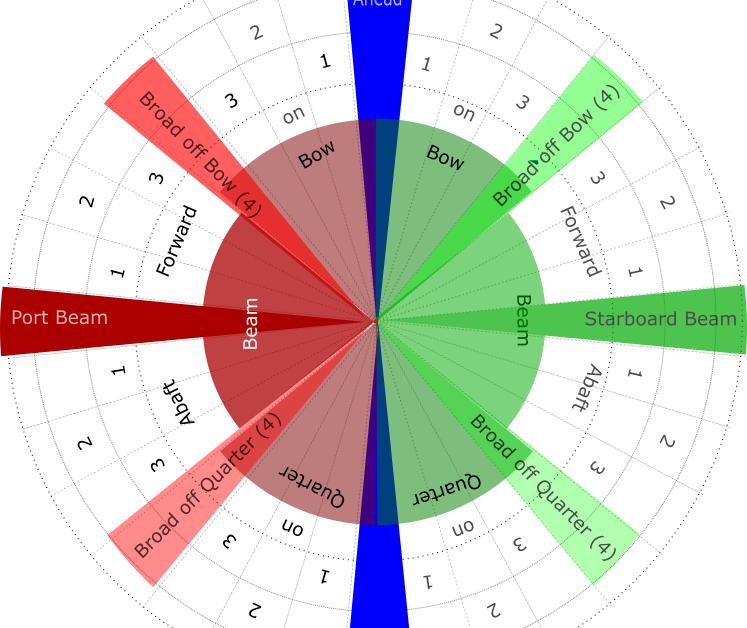A method is needed for crew to communicate bearings of the wind and objects relative to the boat. Today we use instruments such as a compass and degrees relative to North not the boat’s heading (larger vessels have other instruments such as a Pelorus). However, there is a reliable system oriented on the boat which needs only the eye. This system is easy to understand, can be worked without instruments and, given the vagaries of steering a course by compass is adequate for most purposes. Other than eyesight, the only skills needed are counting to three, knowing Port from Starboard and Ahead from Astern.
The system is essentially the same as the 32 point Compass but relative to the boat’s head and not North. The basis of the system is the relative ease of mentally bisecting an angle (but trisecting is harder). The circle is sub-divided into a total of 32 points. Each point is 11¼° but this is relevant solely if converting to the 360⁰ system which only the curious, or ill matched crew, would need to do.
The boat has four quarters, each sub-divided to give four eighths. Thus four times two times four=32 points. This conveniently agrees with the 32 points compass although relative to the boat not North. The Port and Starboard side each has Bow and Stern quarters split by Broad eighths 1The term Fine, as in fine on the bow, generally means one point but does not appear to be consistently used. , four points (45⁰) from the Bow or Quarter (Stern). Note that Quarter means near the Stern as Stern is implicit. These directions are easy to estimate by eye but as s a double check a man’s fist held at arm’s length is just less than one point and an outstretched had just less than two. The system is most easily described by the diagram.

The four Primary directions are Dead Ahead, Dead Astern, on the Port Beam or Starboard Beam. Bisecting each gives the intermediate directions of Broad off the Port/Starboard Bow or Port/Starboard (Stern) Quarter. A second bisection gives 2 points from one of these eight points. The third bisection results in either 1 or 3 points.
The 1,2,3 points are On the Bow or Quarter (Stern) until the 4 or Broad point which is Off (if Broad was referenced from the Beam then Forward or Abaft would also be needed so that form is not used). Amidships they are Forward of the Beam, directly On the Beam, or Abaft the Beam. In practice the user will quickly build a mental model of this and be able to apply it instinctively. Some ships had “Dumb Compass” cards as an aide memoire. However, the steps required are:
The lookout as well as the seeker of the direction, who might be at the bow or stern or up a mast, needs to:
- Mentally position at the centre of the boat with the four quarters defined by the Primary points of Bow ahead, Stern behind, Port Beam amidships left and Starboard beam right.
- Dead Ahead or Astern. Done.
- Port or Starboard side?
- Port/Starboard Beam. Done.
The first bisection of adjacent Primary points is a Broad point.
- Broad on the Port/Starboard Bow or Quarter (Stern). Done.
The second bisection between a Primary point and an adjacent Broad point is a 2 point.
- 2 points nearest an end is 2 points on the Bow/Quarter. Done.
- 2 points nearest beam is 2 points forward/abaft the Port/Starboard Beam. Done.
The third and final mental bisection will be harder but if a 2 point does not suit then it is only necessary to decide if halfway to the nearest Primary or Broad point is more suitable. The description will vary according to the quarter.
- Bisecting between a 2 point and an adjacent Broad point is 3 points on the Bow/Quarter or Port/Starboard Beam. Done
- Bisecting between a 2 point and an adjacent Primary point is 1 point on the Bow/Quarter or Forward/Abaft the Port/Starboard Beam. Done
The ability to quickly find the reciprocal or perpendicular direction is useful in a sailing vessel. If a direction reciprocal to the given point is needed then the last two terms are changed to their complements such as, 3 points Forward of the Starboard Beam becomes 3 points Abaft the Port Beam.
The simplest way to find a perpendicular point is to visualise the relevant adjacent quarter and pick the same point in that quarter. So, one perpendicular left of 3 points on the Starboard Bow is 1 point on the Port Bow.
The points system when used for magnetic compass directions can extend to fractional points but that is not appropriate for visual relative directions without instruments.
The system has much to commend it as, once learned, it is intuitive, unambiguous and needs no instruments.
Notes and References
- 1The term Fine, as in fine on the bow, generally means one point but does not appear to be consistently used.
